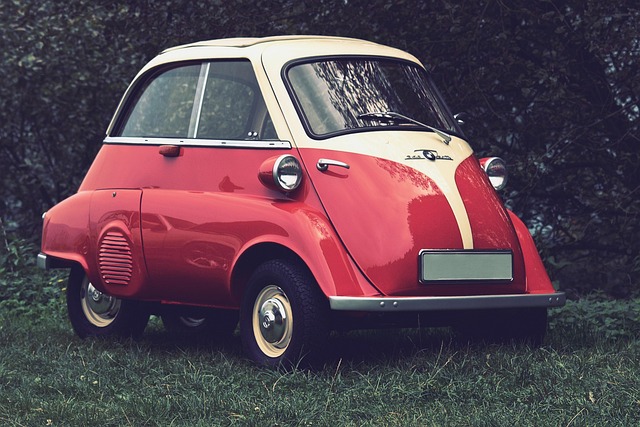Select microcars offer a revolutionary approach to urban mobility, combining compact size, agility, and eco-friendliness. They navigate dense city streets easily, reduce congestion, and lower parking/insurance costs. With growing acceptance of shared mobility models, these vehicles are gaining popularity as cost-effective alternatives to traditional cars. Despite regulatory challenges, microcars promote sustainability, community engagement, and lower carbon emissions, transforming urban navigation while keeping costs low.
“In the realm of urban transportation, small urban vehicles (SUVs), or microcars, are revolutionizing the way we navigate through bustling metropolises. This article explores the potential of these compact marvels in tackling urban congestion and environmental concerns. From design innovations that pack a punch to their positive environmental impact, select microcars offer a sustainable and efficient solution.
We’ll delve into how these tiny vehicles can carve out a significant niche in urban spaces, while also navigating the legal aspects for owners, ensuring a smooth ride ahead.”
- Unlocking the Potential of Microcars in Urban Spaces
- Design and Innovation: Tiny Vehicles, Big Impact
- The Environmental Benefits of Small Urban Vehicles
- Navigating Regulations: Legal Aspects for Microcar Owners
Unlocking the Potential of Microcars in Urban Spaces

Unlocking the potential of microcars in urban spaces is a game-changer for efficient and sustainable mobility. These compact vehicles, also known as select microcars, are perfectly suited to navigate the dense streets and cramped parking spots that characterize modern cities. Their small size offers numerous advantages, from reduced congestion to easier access to hard-to-reach areas. With many urban areas embracing shared mobility models, city zip cars based on microcar technology are becoming increasingly popular, providing a cost-effective and eco-friendly alternative to traditional cars.
Registering a microcar may seem like a daunting task due to its unique characteristics, but it opens up exciting possibilities for urban commuting. Small car insurance quotes can be more affordable compared to larger vehicles, making them an attractive option for both individual owners and fleet operators. The compact dimensions also mean that parking and storage costs are significantly lower, further enhancing the microcar’s appeal in densely populated areas.
Design and Innovation: Tiny Vehicles, Big Impact

The world of small urban vehicles (SUVs) has seen a remarkable evolution, with designers pushing the boundaries of what’s possible in tiny packages. These aren’t just miniature versions of traditional cars; they are innovative, efficient, and often environmentally friendly solutions for modern city dwellers. Known as microcars, these compact vehicles prioritize maneuverability, agility, and smart design to offer a unique driving experience.
The aesthetic and engineering prowess on display in microcars is truly remarkable. From sleek, futuristic models with advanced safety features to classic, vintage designs that evoke nostalgia, there’s a microcar for every taste. Moreover, the focus on sustainability is evident in many modern microcar racing events, where manufacturers showcase their latest eco-friendly technologies. Even in the realm of vintage microcar restoration, enthusiasts preserve historical models, ensuring these small but significant vehicles continue to leave their mark on urban landscapes and offer an efficient, enjoyable way to navigate city streets—the smallest cars for city driving just got a lot more exciting!
The Environmental Benefits of Small Urban Vehicles

Small urban vehicles, particularly microcars, offer a range of environmental benefits that make them an attractive choice for eco-conscious city dwellers. Their compact size allows for easier maneuvering in tight spaces, reducing traffic congestion and minimizing the need for expansive parking areas. This efficiency contributes to lower carbon emissions not just from the vehicle itself but also from infrastructure associated with larger cars and trucks.
Furthermore, microcars promote sustainable urban transport by encouraging a shift towards personal vehicles that are more energy-efficient and less reliant on fossil fuels. Many enthusiasts even engage in DIY microcar modifications, enhancing their performance and aesthetics while keeping costs low. This do-it-yourself approach not only fosters a sense of community but also aligns with the goal of creating a greener and more sustainable urban environment.
Navigating Regulations: Legal Aspects for Microcar Owners

Navigating Regulations presents a unique challenge for Microcar owners. While Select Microcars offer an exciting alternative to traditional vehicles, understanding legal aspects is crucial for safe and compliant ownership. Each jurisdiction has specific regulations governing vehicle registration, safety standards, and roadworthiness, especially for such niche vehicles. Owning an electric microcar range introduces additional considerations regarding emissions and battery disposal.
Obtaining accurate small car insurance quotes is essential to protect against unforeseen incidents. Additionally, classic microcar shows serve as platforms for enthusiasts to exchange knowledge and celebrate the history of these compact vehicles. Staying informed about local laws and engaging with communities passionate about microcars ensures a seamless ownership experience while adhering to necessary legal frameworks.
Small urban vehicles, or microcars, present a compelling solution for navigating dense city landscapes. By leveraging innovative design and offering significant environmental benefits, these compact conveyances have the potential to revolutionize urban mobility. However, understanding and adhering to legal regulations is crucial for prospective owners. As the popularity of select microcars continues to grow, cities may need to adapt infrastructure and policies to accommodate this efficient and eco-friendly trend.
